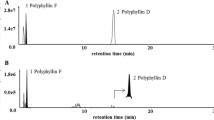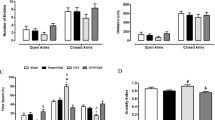Abstract
Leonurus sibiricus, also called motherwort, is a well-known functional food and medicinal herb. It has been known to possess beneficial properties for women’s health, especially for aged women. Estrogen deficiency in the menopause could induce lipid metabolic abnormalities in body fat, resulting in obesity. In this study, the inhibitory effects of L. sibiricus on obesity after the menopause were investigated. Female C57BL/6 mice were ovariectomized and fed high-fat diet (HFD) for 12 weeks. Following an induction period, aqueous extracts of L. sibiricus (LS) were orally administrated for 6 weeks. The body, uterine, and visceral fat weights were measured immediately after the animals were killed. Histological analysis was performed to monitor fat and liver. Serum levels of glucose, triglyceride, total cholesterol, and LDL-cholesterol were evaluated. In addition, the expression of lipases was analyzed. Total body weight was significantly decreased by LS treatment. Histological changes in adipocyte size were shown along with a decrease of visceral fat weight in the LS-treated group. In addition, the fat infiltration of liver was reduced by LS administration. LS-treated mice experienced decreases of serum triglyceride, total cholesterol, and LDL-cholesterol levels. The expression of HSL and ATGL was significantly increased by LS treatment. These results suggest that LS could regulate the lipid metabolism via an increase of lipases expression in ovariectomized and HFD-fed mice. LS might be a novel candidate for a functional food to inhibit weight gain after the menopause.






Similar content being viewed by others
References
Kwon JK, Kim JH, Choi H, Chang IH, Park BR, Kwon SS, Lee ES, Choi GY, Lee JJ, Lee IS (2014) Voiding characteristics and related hormonal changes in peri-menopausal and post-menopausal women: a preliminary study. Maturitas. doi:10.1016/j.maturitas.2014.07.011
Bernhard LA, Sheppard L (1993) Health, symptoms, self-care, and dyadic adjustment in menopausal women. J Obstet Gynecol Neonatal Nurs 22(5):456–461
Kato I, Toniolo P, Akhmedkhanov A, Koenig KL, Shore R, Zeleniuch-Jacquotte A (1998) Prospective study of factors influencing the onset of natural menopause. J Clin Epidemiol 51(12):1271–1276
Soules MR, Sherman S, Parrott E, Rebar R, Santoro N, Utian W, Woods N (2001) Executive summary: stages of Reproductive Aging Workshop (STRAW). Fertil Steril 76(5):874–878
Schaffer J, Fantl JA (1996) Urogenital effects of the menopause. Baillieres Clin Obstet Gynaecol 10(3):401–417
Gustafsson JA (2003) What pharmacologists can learn from recent advances in estrogen signalling. Trends Pharmacol Sci 24(9):479–485
Heine PA, Taylor JA, Iwamoto GA, Lubahn DB, Cooke PS (2000) Increased adipose tissue in male and female estrogen receptor-alpha knockout mice. Proc Natl Acad Sci USA 97(23):12729–12734
Murata Y, Robertson KM, Jones ME, Simpson ER (2002) Effect of estrogen deficiency in the male: the ArKO mouse model. Mol Cell Endocrinol 193(1–2):7–12
Jelenik T, Roden M (2013) How estrogens prevent from lipid-induced insulin resistance. Endocrinology 154(3):989–992
Roden M (2005) Muscle triglycerides and mitochondrial function: possible mechanisms for the development of type 2 diabetes. Int J Obes (Lond) 29:(Suppl 2)S111–S115
Samuel VT, Petersen KF, Shulman GI (2010) Lipid-induced insulin resistance: unravelling the mechanism. Lancet 375(9733):2267–2277
Jelenik T, Roden M (2013) Mitochondrial plasticity in obesity and diabetes mellitus. Antioxid Redox Signal 19(3):258–268
Hotamisligil GS (2010) Endoplasmic reticulum stress and the inflammatory basis of metabolic disease. Cell 140(6):900–917
Liang YQ, Akishita M, Kim S, Ako J, Hashimoto M, Iijima K, Ohike Y, Watanabe T, Sudoh N, Toba K, Yoshizumi M, Ouchi Y (2002) Estrogen receptor beta is involved in the anorectic action of estrogen. Int J Obes Relat Metab Disord 26(8):1103–1109
Saengsirisuwan V, Pongseeda S, Prasannarong M, Vichaiwong K, Toskulkao C (2009) Modulation of insulin resistance in ovariectomized rats by endurance exercise training and estrogen replacement. Metabolism 58(1):38–47
Wang P, Mariman E, Renes J, Keijer J (2008) The secretory function of adipocytes in the physiology of white adipose tissue. J Cell Physiol 216(1):3–13
Wang Y, Beydoun MA, Liang L, Caballero B, Kumanyika SK (2008) Will all Americans become overweight or obese? Estimating the progression and cost of the US obesity epidemic. Obesity (Silver Spring) 16(10):2323–2330
Davis SR, Castelo-Branco C, Chedraui P, Lumsden MA, Nappi RE, Shah D, Villaseca P (2012) Understanding weight gain at menopause. Climacteric 15(5):419–429
Ryan AS, Nicklas BJ, Berman DM (2002) Hormone replacement therapy, insulin sensitivity, and abdominal obesity in postmenopausal women. Diabetes Care 25(1):127–133
Geary N, Asarian L, Korach KS, Pfaff DW, Ogawa S (2001) Deficits in E2-dependent control of feeding, weight gain, and cholecystokinin satiation in ER-alpha null mice. Endocrinology 142(11):4751–4757
Wallen WJ, Belanger MP, Wittnich C (2001) Sex hormones and the selective estrogen receptor modulator tamoxifen modulate weekly body weights and food intakes in adolescent and adult rats. J Nutr 131(9):2351–2357
Brown LM, Gent L, Davis K, Clegg DJ (2010) Metabolic impact of sex hormones on obesity. Brain Res 1350:77–85
Dall’Acqua S, Tome F, Vitalini S, Agradi E, Innocenti G (2009) In vitro estrogenic activity of Asplenium trichomanes L. extracts and isolated compounds. J Ethnopharmacol 122(3):424–429
NICE (2006) Obesity: the prevention, identification, assessment and management of overweight and obesity in adults and children. National Institute for Health and Clinical Excellence, London
Carrera Boada CA, Martinez-Moreno JM (2013) Current medical treatment of diabetes type 2 and long term morbidity: how to balance efficacy and safety? Nutr Hosp 28(Suppl 2):3–23
Shin HY, Kim SH, Kang SM, Chang IJ, Kim SY, Jeon H, Leem KH, Park WH, Lim JP, Shin TY (2009) Anti-inflammatory activity of motherwort (Leonurus sibiricus L.). Immunopharmacol Immunotoxicol 31(2):209–213
Pitschmann A, Zehl M, Heiss E, Purevsuren S, Urban E, Dirsch VM, Glasl S (2016) Quantitation of phenylpropanoids and iridoids in insulin-sensitising extracts of Leonurus sibiricus L. (Lamiaceae). Phytochem Anal 27(1):23–31
Yuan FL, Xu RS, Jiang DL, He XL, Su Q, Jin C, Li X (2015) Leonurine hydrochloride inhibits osteoclastogenesis and prevents osteoporosis associated with estrogen deficiency by inhibiting the NF-kappaB and PI3 K/Akt signaling pathways. Bone 75:128–137
Schmidt S, Jakab M, Jav S, Streif D, Pitschmann A, Zehl M, Purevsuren S, Glasl S, Ritter M (2013) Extracts from Leonurus sibiricus L. increase insulin secretion and proliferation of rat INS-1E insulinoma cells. J Ethnopharmacol 150(1):85–94
Lee MJ, Lee HS, Park SD, Moon HI, Park WH (2010) Leonurus sibiricus herb extract suppresses oxidative stress and ameliorates hypercholesterolemia in C57BL/6 mice and TNF-alpha induced expression of adhesion molecules and lectin-like oxidized LDL receptor-1 in human umbilical vein endothelial cells. Biosci Biotechnol Biochem 74(2):279–284
Narukawa Y, Niimura A, Noguchi H, Tamura H, Kiuchi F (2014) New diterpenoids with estrogen sulfotransferase inhibitory activity from Leonurus sibiricus L. J Nat Med 68(1):125–131
Kuchta K, Ortwein J, Rauwald HW (2012) Leonurus japonicus, Leonurus cardiaca, Leonotis leonurus: a novel HPLC study on the occurrence and content of the pharmacologically active guanidino derivative leonurine. Pharmazie 67(12):973–979
D’Eon TM, Souza SC, Aronovitz M, Obin MS, Fried SK, Greenberg AS (2005) Estrogen regulation of adiposity and fuel partitioning. Evidence of genomic and non-genomic regulation of lipogenic and oxidative pathways. J Biol Chem 280(43):35983–35991
Ludgero-Correia A Jr, Aguila MB, Mandarim-de-Lacerda CA, Faria TS (2012) Effects of high-fat diet on plasma lipids, adiposity, and inflammatory markers in ovariectomized C57BL/6 mice. Nutrition 28(3):316–323
Langin D (2006) Adipose tissue lipolysis as a metabolic pathway to define pharmacological strategies against obesity and the metabolic syndrome. Pharmacol Res 53(6):482–491
Stubbins RE, Najjar K, Holcomb VB, Hong J, Nunez NP (2012) Oestrogen alters adipocyte biology and protects female mice from adipocyte inflammation and insulin resistance. Diabetes Obes Metab 14(1):58–66
Hertrampf T, Gruca MJ, Seibel J, Laudenbach U, Fritzemeier KH, Diel P (2007) The bone-protective effect of the phytoestrogen genistein is mediated via ER alpha-dependent mechanisms and strongly enhanced by physical activity. Bone 40(6):1529–1535
Picot J, Jones J, Colquitt JL, Gospodarevskaya E, Loveman E, Baxter L, Clegg AJ (2009) The clinical effectiveness and cost-effectiveness of bariatric (weight loss) surgery for obesity: a systematic review and economic evaluation. Health Technol Assess 13(41):1–190, 215–357
Richard D, Rochon L, Deshaies Y (1987) Effects of exercise training on energy balance of ovariectomized rats. Am J Physiol 253(5 Pt 2):R740–R745
Kim JH, Meyers MS, Khuder SS, Abdallah SL, Muturi HT, Russo L, Tate CR, Hevener AL, Najjar SM, Leloup C, Mauvais-Jarvis F (2014) Tissue-selective estrogen complexes with bazedoxifene prevent metabolic dysfunction in female mice. Mol Metab 3(2):177–190
Tan Z, Zhou LJ, Mu PW, Liu SP, Chen SJ, Fu XD, Wang TH (2012) Caveolin-3 is involved in the protection of resveratrol against high-fat-diet-induced insulin resistance by promoting GLUT4 translocation to the plasma membrane in skeletal muscle of ovariectomized rats. J Nutr Biochem 23(12):1716–1724
Barrett-Connor E, Schrott HG, Greendale G, Kritz-Silverstein D, Espeland MA, Stern MP, Bush T, Perlman JA (1996) Factors associated with glucose and insulin levels in healthy postmenopausal women. Diabetes Care 19(4):333–340
Rachon D, Vortherms T, Seidlova-Wuttke D, Wuttke W (2007) Effects of dietary equol on body weight gain, intra-abdominal fat accumulation, plasma lipids, and glucose tolerance in ovariectomized Sprague-Dawley rats. Menopause 14(5):925–932
Davies MJ, Baer DJ, Judd JT, Brown ED, Campbell WS, Taylor PR (2002) Effects of moderate alcohol intake on fasting insulin and glucose concentrations and insulin sensitivity in postmenopausal women: a randomized controlled trial. JAMA 287(19):2559–2562
Milewicz A, Tworowska U, Demissie M (2001) Menopausal obesity–myth or fact? Climacteric 4(4):273–283
Shinoda M, Latour MG, Lavoie JM (2002) Effects of physical training on body composition and organ weights in ovariectomized and hyperestrogenic rats. Int J Obes Relat Metab Disord 26(3):335–343
Zoth N, Weigt C, Zengin S, Selder O, Selke N, Kalicinski M, Piechotta M, Diel P (2012) Metabolic effects of estrogen substitution in combination with targeted exercise training on the therapy of obesity in ovariectomized Wistar rats. J Steroid Biochem Mol Biol 130(1–2):64–72
Zimmermann R, Strauss JG, Haemmerle G, Schoiswohl G, Birner-Gruenberger R, Riederer M, Lass A, Neuberger G, Eisenhaber F, Hermetter A, Zechner R (2004) Fat mobilization in adipose tissue is promoted by adipose triglyceride lipase. Science 306(5700):1383–1386
Fredrikson G, Stralfors P, Nilsson NO, Belfrage P (1981) Hormone-sensitive lipase of rat adipose tissue. Purification and some properties. J Biol Chem 256(12):6311–6320
Acknowledgments
This research was supported by National Research Foundation of Korea (NRF) grant funded by the Korean government (MSIP) (NRF-2015R1A4A1042399).
Author information
Authors and Affiliations
Corresponding author
Ethics declarations
Conflict of interest
The authors declare that they have no conflict of interest.
Additional information
J. Kim and M. H. Kim contributed equally.
Rights and permissions
About this article
Cite this article
Kim, J., Kim, M.H., Choi, Y.Y. et al. Inhibitory effects of Leonurus sibiricus on weight gain after menopause in ovariectomized and high-fat diet-fed mice. J Nat Med 70, 522–530 (2016). https://doi.org/10.1007/s11418-016-0971-7
Received:
Accepted:
Published:
Issue Date:
DOI: https://doi.org/10.1007/s11418-016-0971-7




